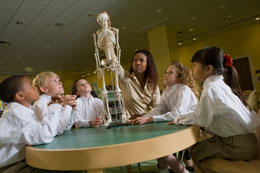Ever wondered how we manage to move around? How, one minute we can stretch and the next minute curl up into a tight ball? What provides the framework to our organs, muscles? All this is done by the human skeletal system. If you want to know how this skeletal system works, read on...

The human skeletal system is a complex structure that is not just a solid frame. The bones are actually living, calciferous structures which work in coordination with other major systems like the muscular system, circulatory system and many other systems, to help our body to function efficiently. The bones have a hollow shaft down the middle which consists of a substance called bone marrow, which is basically an important energy source for our body.
One of the main functions of the skeletal system is to provide a framework to our bodies, without which we would be a heap of skin, organs, blood vessels etc.
The main skeletal system is divided into two parts:
The Axial Skeleton
This part consists of 80 bones. It is further divided into:
- Skull
- Spinal Cord (The Vertebral Column)
- Rib Cage
The Appendicular Skeleton
This part consists of 126 bones. It is further divided into:
- Upper Extremity: This is made up of the pectoral girdle (scapula and shoulder) and the upper limbs (hands, forearms, elbows and arms).
- Lower Extremity: This is made up of the pelvic girdle (sacrum, coccyx and hip bone) and the lower limbs (thighs, knees, legs, ankles, toes).
Working of the Skeletal System
Coordination with Circulatory System
The circulatory system transports blood, with the help of blood vessels, to all the parts of the body, right from your head to your toes. The main constituents of blood -
Hematocytes, i.e Red and White Blood Cells are produced by the
Bone Marrow. The bone marrow is located in the hollow shaft of the bone. The newly formed marrow is red, whereas the older marrow is yellow in color. The bone marrow produces approximately 2.6 million hematocytes per second! If the marrow stops the production of these blood cells, we wouldn't be able to survive for long, since the white blood cells account for the body's immunity to various diseases. In the absence of these white blood cells, even a common cold could assume gigantic proportions and prove fatal. This marrow is also one of the main sources of energy for our body. Thus, the circulatory system will not have any cells to circulate if the bone stops making hematocytes.
Coordination with Muscular System
The main work of the human skeletal system, along with the muscular system, is to provide movement. The skeletal system is mainly made up of calcified bones and a softer mass called cartilage, and is connected to the muscles by tendons. When the bone has to move, the muscle attached to it contracts or releases, thus causing the bone attached to it, to move. The muscles by themselves cannot cause any movement. They need the help of the skeleton to do so.
The cartilage also helps in the smooth movements of joints without causing too much wear and tear. The cartilage forms a padding/layer between the bones of a joint, so that they can move comfortably without too much friction. The cartilage can wear away or thin down over a period of time, due to friction caused by excessive use of the joint. The skeleton provides the basic framework for the body and also controls the growth of our body.
Osteoblasts, which are growth cells, release proteins when the bone moves, in response to the contraction or expansion of muscles, resulting in growth.
Coordination with Other Systems
The skeletal system is a store of calcium and phosphorous. It replenishes these minerals in the blood when their supply is depleted. Also, when there are build-ups of these minerals, the bones absorb the excess minerals, thus, maintaining the balance of mineral levels in blood. The skeletal system also protects all the organs in the body with the help of the other systems. It is a strong system capable of withstanding most impacts from accidents without causing injury to the organs encased in them. It protects the fragile lungs, and the very crucial brain and heart.
Nutrient canals are tiny openings through which the nerves pass in and out of the bones. They supply the bone tissue with oxygen and nutrients. Bones also have the ability to regenerate and heal themselves when they break. Bone cells are also responsible for the release of osteocalcin hormone, which regulates fat deposition and glucose levels.
Since the skeletal system is very important, it is best to take care of it and keep it strong by replenishing the calcium levels in the body. Exercising is another good method of strengthening this system.


 The human skeletal system is a complex structure that is not just a solid frame. The bones are actually living, calciferous structures which work in coordination with other major systems like the muscular system, circulatory system and many other systems, to help our body to function efficiently. The bones have a hollow shaft down the middle which consists of a substance called bone marrow, which is basically an important energy source for our body.
The human skeletal system is a complex structure that is not just a solid frame. The bones are actually living, calciferous structures which work in coordination with other major systems like the muscular system, circulatory system and many other systems, to help our body to function efficiently. The bones have a hollow shaft down the middle which consists of a substance called bone marrow, which is basically an important energy source for our body.